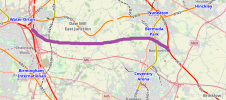Nottingham59
Established Member
In an Alternative Universe, how much capacity could have been added by running longer trains on the WCML, instead of building HS2?
To get the most capacity out of HS2 Phase One, it will be necessary to build 420m platforms at Crewe and Preston and Carlise, to allow more HS2 services to run double units through the bottlenecks of Colwich Junction and just six platforms at Euston. How much more would it have cost to extend platforms at the other main stations on the West Coast Mainline?
This thread is about long-distance trains, not London commuter services. And I'm not saying that this should have been the choice way back in 2009 when HS2 started. But with the benefit of hindsight, I'm exploring whether longer trains could have run on the WCML, and see if those lessons might apply to other routes like ECML and GWML. Any comments or (constructive) criticism welcome.
== == == == ==
For what it's worth, these are my thoughts about how we could have maximised the capacity of the WCML by running longer trains. I'd standardise on a train length of 520m (being 20x26m), so that a split train could reach all stations currently served by an 11-car Pendolino (265m). A 400m HS2 train has 1100 seats (2.75Pax/metre), so these 520m trains should be able to carry 1430 passengers, well over twice the 607 capacity of a Pendolino.
PHASE ONE
HS2 is being built with six platforms at Euston. It will carry five 400m trains (3tph to Birmingham and 2tph splitting at Crewe) plus five 200m to elsewhere, giving an uplift of 8,250 Pax/hour. This will cost around £40bn at 2019 prices, so £50bn at current prices. It seems to me that running longer trains on WCML would been a far cheaper way to add capacity than building a whole new line. What do you think?
PHASE TWO
The longer platforms added in Phase One would increase capacity without using any more paths on the WCML. But they would also add station capacity in Central Birmingham and Central Manchester. To exploit this, I'd propose a Phase Two which added limited new lines to bypass specific bottlenecks as cheaply as possible
To get the most capacity out of HS2 Phase One, it will be necessary to build 420m platforms at Crewe and Preston and Carlise, to allow more HS2 services to run double units through the bottlenecks of Colwich Junction and just six platforms at Euston. How much more would it have cost to extend platforms at the other main stations on the West Coast Mainline?
This thread is about long-distance trains, not London commuter services. And I'm not saying that this should have been the choice way back in 2009 when HS2 started. But with the benefit of hindsight, I'm exploring whether longer trains could have run on the WCML, and see if those lessons might apply to other routes like ECML and GWML. Any comments or (constructive) criticism welcome.
== == == == ==
For what it's worth, these are my thoughts about how we could have maximised the capacity of the WCML by running longer trains. I'd standardise on a train length of 520m (being 20x26m), so that a split train could reach all stations currently served by an 11-car Pendolino (265m). A 400m HS2 train has 1100 seats (2.75Pax/metre), so these 520m trains should be able to carry 1430 passengers, well over twice the 607 capacity of a Pendolino.
PHASE ONE
- Euston Extend P16 to 530m and build another three (P17, 18, 19) to the West of the current station, connected to the WCML fast lines, with a mezzanine departure lounge above the tracks to separate departing passengers from arrivals. This would use less space than has already been cleared for HS2. Four 530m platforms have the same passenger-carrying capacity as five HS2 platforms (420m), or nine Pendolino platforms. Estimated cost: £1bn for the station extension and railway, and £1-2bn for the land, because it's London. I'd not bother with oversite development. I've not costed changes to handle the increased pedestrian flows to and from the street and the tube, but from the cost for HS2 Euston I'd guess £1-2bn.
- Milton Keynes, Rugby, Crewe, Warrington BQ, Preston, Lancaster, Carlisle, Wilmslow, Stoke-on-Trent, Coventry, Birmingham International There seems to be space at each of these to extend two or four existing platforms to 530m, relatively easily. Most could be done within existing railway land: Carlisle would require some demolition. Coventry would need P1 extending to the East, P4 extending to the West, plus new bay platforms. Stations north of Crewe will need extending anyway to get the most out of HS2 phase one. Estimated cost: £50m per platform island.
- Birmingham Extending New Street would be impractical, so I would build a new seven-platform station at Curzon St, like HS2, but with classic platforms able to take trains from the rest of the network. Connections to the line from Water Orton and viaducts to join the WCML just west of Adderley Park station, along the line shown in this map.

Cost £500m for the new station (same as HS2) and £1bn for the connecting viaducts.
- Manchester Mainline Manchester could be served by splitting at Crewe or Stoke, but Piccadilly really needs longer platforms. Extend P1 to 520m, and build two new platforms (P0 and P-1) on the existing railway structure that used to carry the goods lines, with platform P-1 cantilevered out over Sheffield St. Cost £250m.
Previously discussed here:
How to add 400m platforms to Manchester Piccadilly
If HS2 Phase 2B is not going to be built, then capacity to Manchester will be severely limited by the number of trains that can get through Colwich Juntion and Stafford. The only way to increase capacity to Manchester is to run longer trains. This is how I would add 3 x 400m platforms at... www.railforums.co.uk
www.railforums.co.uk
- Manchester Suburban To avoid conflicts with trains from Glossop and Rose Hill Marple, I'd convert those routes to Metrolink tram-train and connect them into the main Metrolink network with a new viaduct across the River Medlock from the Ancoats viaduct to join the metrolink tracks to the East of Piccadilly station. I've not costed this, but should be possible for well under £1bn.
(Alternatively, build new suburban platforms (P-2, P-3) to the east of Piccadilly, encroaching on the HS2 station site, and serve them with a new 1.5km twin-track viaduct to Ardwick, to make eight tracks out of Piccadilly in total. Cost £250m for the suburban platforms and land, and £300m for the new viaduct.)
- Stockport It would be straightforward but not cheap to extend Stockport platforms northwards, on a high-level structure well above existing street level. Merging onto the main Stockport Viaduct would compromise that heritage landmark, so it may be better to construct a new twin-track bridge alongside the existing, and merge onto the mainline to the north of the river. Cost £500m (same as Curzon St) to rebuild the station, and £500m for a second bridge across the river.
- Glasgow Straightforward to extend P1 and P2 across the river Clyde. As discussed here:
400m platforms at Glasgow Central?
[Crayon alert!] Could space be found for 400m long platforms at Glasgow Central? When HS2 phase 1 starts, the fastest route from London to Edinburgh will be via HS2 phase 1 and Carlisle. So I'm expecting England-Scotland passenger traffic via Carlisle to grow strongly over the next twenty... www.railforums.co.uk
www.railforums.co.uk
- Liverpool, Edinburgh I don't think 530m platforms can be fitted in here, so serve these and other intermediate stations on the WCML with trains splitting at Crewe or Carlisle.
HS2 is being built with six platforms at Euston. It will carry five 400m trains (3tph to Birmingham and 2tph splitting at Crewe) plus five 200m to elsewhere, giving an uplift of 8,250 Pax/hour. This will cost around £40bn at 2019 prices, so £50bn at current prices. It seems to me that running longer trains on WCML would been a far cheaper way to add capacity than building a whole new line. What do you think?
PHASE TWO
The longer platforms added in Phase One would increase capacity without using any more paths on the WCML. But they would also add station capacity in Central Birmingham and Central Manchester. To exploit this, I'd propose a Phase Two which added limited new lines to bypass specific bottlenecks as cheaply as possible
- Colwich bypass New 5km twin-track line from Hixon diverting the line from Stoke to a grade-separated junction near Rugeley. By eliminating crossing moves, this would also increase the capacity of the route through Shugborough Tunnel. Cost £1bn with short tunnel under Coley Lane hill.
- Water Orton to Lichfield Follwing the route of HS2, but merging onto the WCML at Huddlesford east of Lichfield. There is no need to go round Lichfield to join the mainline at Handsacre. This section would allow Birmingham-Scotland and Birmingham-Manchester flows to avoid the slow route through Wolverhampton, and enable Euston-Curzon St-Manchester paths to fill the 520m trains all the way north. 20km of new line: Cost £2.5bn.
- Water Orton to Bedworth Merging onto the WCML east of Bedworth. 20km of new line: cost £2.5bn, as shown here:

- Delta junction As HS2, but connecting onto the Water Orton - Birmingham line. There is no need for six tracks between Water Orton and the city centre. Cost £1bn.
- Birmingham Interchange. Four-platform Park and Ride station with big car park, situated off the M42 somewhere near Water Orton. Cost £500m.


